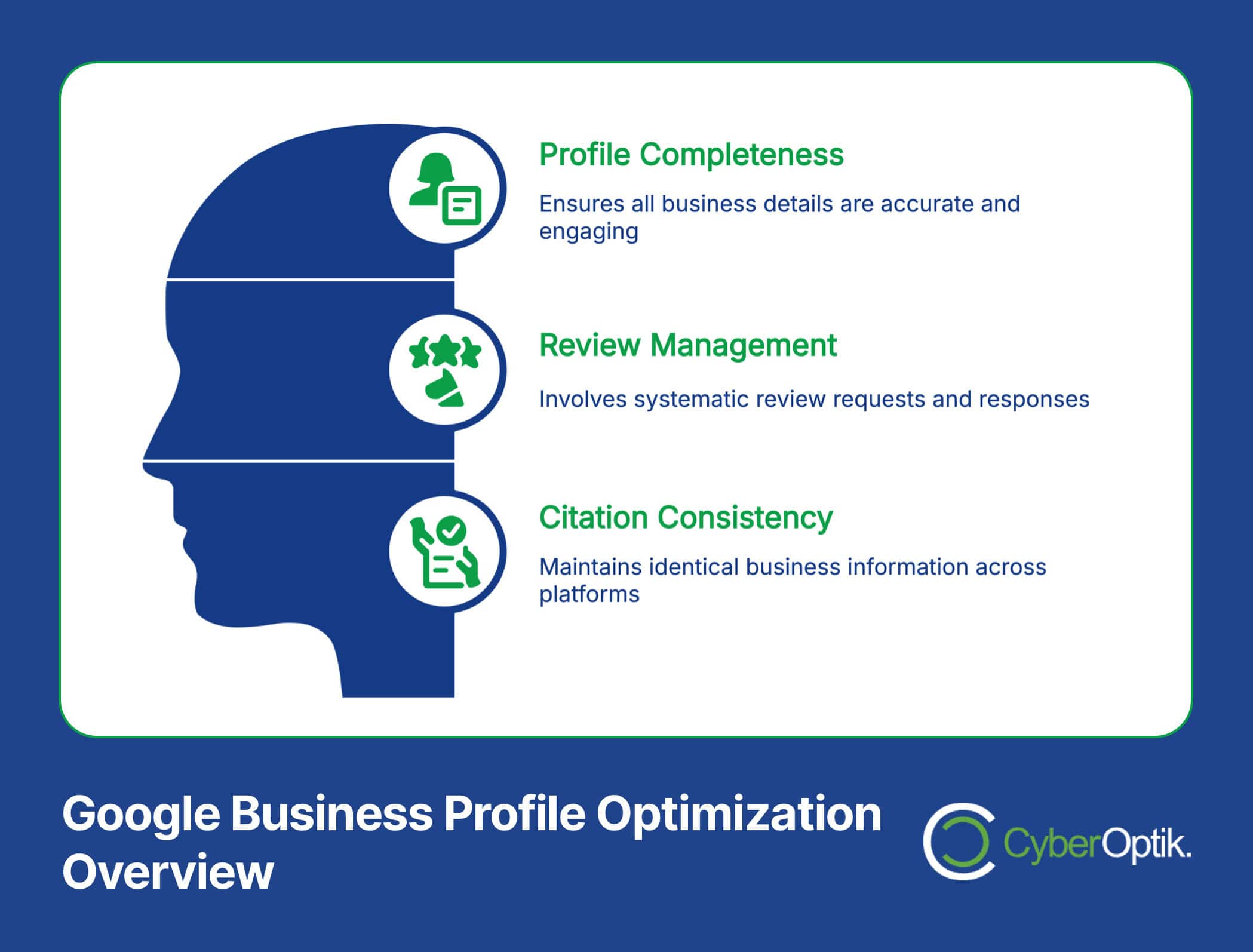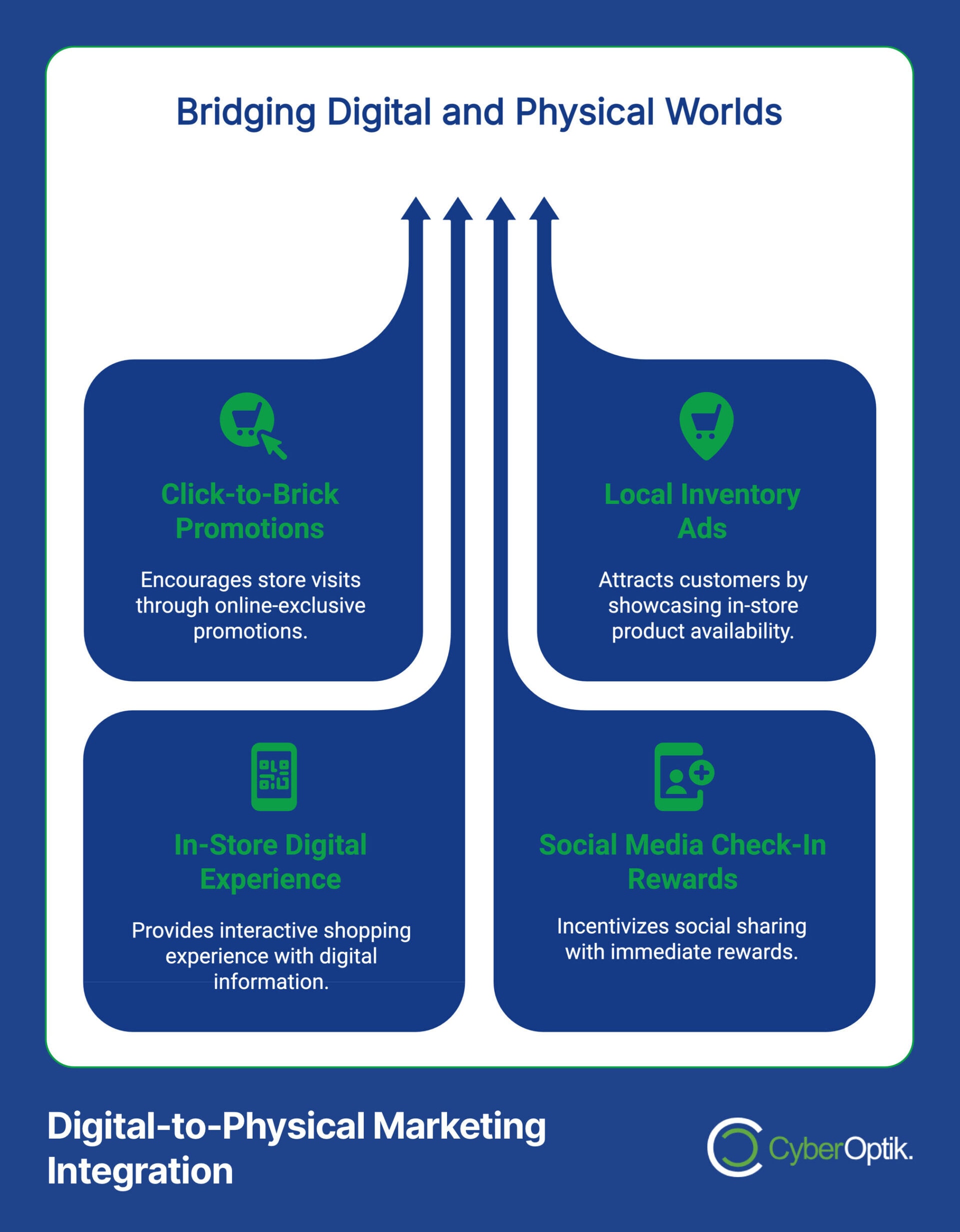For local businesses, effective marketing serves as the bridge between potential customers and your products or services. Finding the right mix of strategies to both drive foot traffic and enhance online visibility remains a critical challenge for business owners. Currently, 63% of small businesses plan to increase their marketing budgets, recognizing the importance of strategic promotion in today’s competitive landscape. (Source: PostcardMania)
In Chicago and beyond, we’ve seen firsthand how proper marketing implementation can transform local businesses. The right approach connects you with nearby customers actively searching for what you offer. But which strategies deliver the best results for your specific situation?
This guide explores proven marketing tactics for local businesses seeking to increase both their physical store traffic and digital presence. We’ll examine both traditional methods and digital approaches that work together to create a comprehensive marketing strategy.
Understanding the Local Business Marketing Landscape
Local businesses face unique marketing challenges that differ from larger corporations. Competition comes not only from nearby establishments but also from national chains and online retailers. Understanding this landscape helps create more effective strategies.
The foundation of local business success lies in connecting with the community. Small businesses have an advantage here – the ability to create personal relationships with customers and truly understand local needs. Many local consumers specifically choose to shop at small businesses to support their community.
The local business marketing environment requires a distinctive approach that balances traditional foot traffic strategies with digital tactics. Local consumers follow specific patterns when deciding where to shop or which services to use. Research indicates that 13% of consumers search for local businesses daily, while 47% do so weekly. (Source: Cox Media)
Before implementing specific tactics, local businesses should understand these common challenges:
- Limited marketing budget compared to larger competitors
- Resource constraints for executing comprehensive campaigns
- Difficulty measuring ROI across multiple marketing channels
- Keeping pace with digital marketing trends while running day-to-day operations
- Creating consistent messaging across both online and offline channels
With these challenges in mind, let’s explore proven strategies to boost both foot traffic and online presence for your local business.
Strategies to Boost Foot Traffic
Physical visits remain crucial for local businesses with brick-and-mortar locations. Increasing foot traffic directly impacts revenue and creates opportunities for in-person relationship building. Let’s examine three effective strategies for driving more customers to your door.
Before we dive into specific tactics, consider how these strategies compare in terms of implementation effort, cost, and potential impact:
| Strategy | Implementation Difficulty | Cost Level | Time to Results | Potential Impact |
|---|---|---|---|---|
| Community Events | Medium-High | Medium-High | Short-term | High for immediate traffic |
| Digital Signage | Medium | Medium | Medium-term | Medium-High, consistent |
| Mobile Marketing | Medium | Low-Medium | Medium-term | Medium, targeted |
| Local Partnerships | Low-Medium | Low | Medium-term | Medium, relationship-based |
This comparison helps prioritize which strategies might work best for your specific business needs. Let’s explore each approach in detail.
Host Community Events
Community events create immediate foot traffic while building lasting connections with local customers. These events position your business as an active community member rather than just another storefront.
Retailers that incorporate experiential elements like product demonstrations and workshops consistently see higher customer engagement compared to those offering traditional shopping experiences alone. (Source: Crown TV)
Successful community events don’t need to be elaborate or expensive. Consider these essential elements when planning your next event:
- Clear Purpose: Define specific goals (introducing new products, thanking customers, etc.)
- Relevant Theme: Align with your business values and customer interests
- Strategic Timing: Schedule during periods when you need traffic boosts
- Promotion Plan: Use both digital and physical methods to announce the event
- Follow-up Strategy: Capture contact information for future marketing
Events create valuable content for social media and email marketing, extending their impact well beyond the actual day. Consider hosting seasonal events, workshops, demonstrations, or partnering with complementary local businesses for maximum impact.
Leverage Digital Signage
Digital signage represents a powerful modern approach to traditional storefront advertising. These dynamic displays capture attention and drive foot traffic in ways static signs cannot match.
The impact is significant – digital signage at storefronts increases foot traffic by 17% on average, providing a measurable boost to physical visits. (Source: Zero-in)
Digital displays offer numerous advantages over traditional signs. They enable real-time updates for promotions, display multiple messages throughout the day, and create vibrant visual interest. Research shows that digital signage captures 400% more views than static displays. (Source: Screenfluence)
For effective implementation, consider these applications:
Window displays attract passing foot traffic with eye-catching promotions. Indoor signage guides customers through your store while highlighting special offers. Menu boards (for restaurants) can boost high-margin item sales through strategic placement and visuals.
The content displayed matters significantly. Focus on clear value propositions, limited-time offers, and visually appealing designs. Effective digital signage should communicate benefits quickly to people passing by. (Source: Resonai)
Mobile Marketing
Mobile marketing bridges the gap between digital strategies and physical foot traffic. As consumers increasingly rely on smartphones for local shopping decisions, mobile-focused tactics become essential for driving store visits.
Surprisingly, only 19% of small businesses actively use local SEO and Google Business Profile optimization, creating an opportunity for businesses that implement these tactics effectively. (Source: NerdWallet)
Location-based mobile marketing includes several effective approaches:
Geotargeted ads display to users within a specific radius of your business. These can be implemented through Google Ads, social media platforms, or specialized location marketing services. Push notifications through your business app alert nearby customers about special offers when they’re in your vicinity.
Local search ads ensure your business appears when people search for relevant products or services near them. These efforts should coordinate with your broader local SEO strategy to maximize visibility when potential customers are nearby.
Mobile marketing requires attention to timing and relevance. Messages should provide immediate value to nearby customers, giving them a compelling reason to visit your location right away.
Strategies to Enhance Online Presence
A strong online presence is no longer optional for local businesses. Today’s consumers research online before visiting physical locations, making your digital footprint a critical path to foot traffic. Let’s examine four essential online strategies every local business should implement.
The following table provides benchmark data for different online marketing approaches to help set realistic expectations:
| Online Strategy | Average Engagement Rate | Lead Conversion Rate | Monthly Time Investment | Typical ROI Timeline |
|---|---|---|---|---|
| Local SEO | N/A | 14.7% (local search to visit) | 5-10 hours | 3-6 months |
| Mobile-Optimized Website | 3-5 pages/visit | 3.5-5% | 2-5 hours (maintenance) | Immediate |
| Social Media Marketing | 1-5% (organic) | 1-3% | 10-15 hours | 1-3 months |
| Email Marketing | 15-25% (open rate) | 2.5-5% | 5-10 hours | 1-2 months |
These benchmarks can help you set realistic goals and properly allocate resources across different digital marketing channels. Now, let’s explore each strategy in detail.
Local SEO & Google Business Profile
Local Search Engine Optimization (SEO) helps your business appear in relevant searches by nearby customers. This strategy focuses specifically on improving visibility in local search results and map listings.

The importance of local search can’t be overstated – 64% of consumers use Google My Business to find local business contact details when they’re ready to engage. (Source: On The Map)
At the center of any local SEO strategy is your Google Business Profile (formerly Google My Business). This free tool provides critical visibility in both Google Search and Maps, often serving as the first impression for potential customers.
For an optimized Google Business Profile, ensure you complete these essential elements:
- Accurate NAP (Name, Address, Phone) information
- Comprehensive business description with relevant keywords
- Current business hours and special holiday schedules
- High-quality photos of your business, products, and team
- Regular posts about offers, events, and updates
Beyond your Google profile, consistent citations across online directories strengthen your local SEO. Ensure your business information appears identically across all platforms, including Yelp, TripAdvisor, and industry-specific directories.
Customer reviews significantly impact local search rankings. Implement a systematic approach to request and respond to reviews across all platforms where your business appears.
Mobile-Optimized Website
Your website often provides the first impression for potential customers. For local businesses, mobile optimization is particularly crucial since many searches happen on smartphones while people are out and about.
The data speaks clearly – 61% of visitors abandon websites that aren’t mobile-friendly, making optimization essential for converting online interest into foot traffic. (Source: Luisa Zhou)
A mobile-optimized website goes beyond simply displaying correctly on smartphones. It provides a seamless user experience specifically designed for mobile users. Key elements include:
Fast loading times keep potential customers engaged. The concept of website speed optimization is particularly important for mobile users who may be searching while on the go. Clear, tap-friendly navigation helps users find essential information quickly without frustration.
Prominent display of crucial information – address, hours, phone number, and directions – supports immediate action. Simplified forms with minimal fields remove barriers to inquiries from mobile devices.
While 73% of small businesses have a website, many fail to optimize for mobile users specifically. This gap presents an opportunity for businesses that prioritize the mobile experience.
Going Deeper
Discover how a custom-designed WordPress website can significantly improve both your online presence and conversion rates.
Social Media Marketing
Social media platforms offer local businesses targeted ways to connect with nearby customers. While national brands focus on broad reach, local businesses can leverage social media for community building and driving local awareness.
Personalization plays a crucial role – 71% of consumers prefer personalized marketing messages that speak directly to their needs and location. (Source: Blue Square Management)
Local businesses should focus on quality over quantity in social media marketing. Rather than trying to maintain a presence on every platform, select 1-2 channels where your target customers are most active. For most local businesses, Facebook and Instagram offer the strongest combination of local targeting and engagement options.
Effective local social media content includes:
Behind-the-scenes glimpses show the human side of your business. Local news and events demonstrate community involvement. Customer spotlights build relationships and provide social proof. Special offers and promotions give followers a reason to visit your location.
Paid social media advertising offers powerful targeting options specifically valuable for local businesses. With platforms like Facebook, you can target users within specific zip codes or even create radius targeting around your physical location.
Email Marketing
Despite the rise of newer channels, email marketing remains one of the most effective tools for local businesses. It provides direct communication with customers who have already shown interest in your business.
The ROI potential is significant – email marketing generates $36 for every $1 spent, making it one of the most cost-effective channels available to local businesses. Yet only 54% of small businesses currently use email marketing, indicating room for competitive advantage. (Source: AI Screen)
For local businesses, email marketing works best when it delivers locally relevant value. Consider these best practices:
- Segmented lists based on customer behavior and preferences
- Location-specific content with events and offers relevant to local customers
- Personalized recommendations based on purchase history
- Mobile-optimized design for easy reading on smartphones
- Clear calls-to-action that drive store visits or website engagement
Email frequency matters – aim for consistency without overwhelming subscribers. For most local businesses, 1-4 emails per month strikes the right balance between staying top-of-mind and avoiding list fatigue.
Measure email performance through open rates, click-through rates, and most importantly, conversion actions like store visits, phone calls, or online purchases.
Measuring Success: Key Performance Indicators
Effective marketing requires measuring results to understand what’s working and what needs adjustment. For local businesses, tracking both online metrics and physical store performance provides a complete picture of marketing effectiveness.
The following table outlines essential KPIs for local business marketing strategies:
| Marketing Channel | Key Performance Indicators | Measurement Method | Success Benchmark |
|---|---|---|---|
| Foot Traffic Strategies | Store visit count, Conversion rate, Average transaction value | Door counters, POS data, Customer surveys | 10-15% increase in quarterly visits |
| Digital Signage | Attention rate, Recall rate, Action rate | Observation, Surveys, Promotional code usage | 20-30% message recall rate |
| Local SEO | Local search rankings, Google Business Profile views, "Get directions" clicks | Google Business Profile Insights, SEO tools | Top 3 ranking for primary keywords |
| Social Media | Local engagement rate, Follower growth, Click-through to website | Platform analytics, UTM tracking | 3-5% engagement rate |
| Email Marketing | Open rate, Click-through rate, Conversion actions | Email platform analytics, Coupon redemptions | 20% open rate, 2.5% CTR |
When measuring digital signage effectiveness, establish clear metrics aligned with business objectives. While brand awareness is important, focus on behavior-based metrics like promotion participation that demonstrate real impact. (Source: IU Digital Signage)
For local businesses, connecting online metrics to in-store activity provides the most valuable insights. Implement these approaches to bridge online and offline measurement:
QR codes on promotional materials track which digital channels drive physical visits. Special offer codes used online but redeemed in-store connect digital engagement to sales. Post-purchase surveys ask customers how they discovered your business.
Regular analysis of these metrics reveals which marketing channels deliver the best return on investment, helping optimize future marketing spend. (Source: Thrive Themes)
Integrating Online and Offline Marketing Strategies
The most successful local marketing approaches don’t treat online and offline strategies as separate efforts. Instead, they create seamless integration between digital presence and physical location.

Digital-to-physical conversion remains the ultimate goal for local businesses with physical locations. Companies that effectively connect these experiences see 81% better customer retention compared to those with disconnected marketing channels. (Source: ComQi)
Consider these powerful integration tactics:
| Integration Approach | Implementation Example | Business Benefit | Customer Benefit |
|---|---|---|---|
| Click-to-Brick Promotions | Online-only coupon redeemable in-store | Measurable online-to-store conversion | Financial incentive to visit |
| Local Inventory Ads | Google ad showing in-stock items at nearby store | Drives ready-to-buy customers to location | Confirms product availability before visit |
| In-Store Digital Experience | QR codes linking to product videos/reviews | Enhanced customer experience | Access to detailed information while shopping |
| Social Media Check-In Rewards | Discount for Facebook/Instagram location tag | Free word-of-mouth advertising | Immediate reward for social sharing |
The goal is to create a consistent brand experience regardless of how customers interact with your business. Messaging should align across all channels, and the transition between online discovery and in-store experience should feel seamless.
Take these action steps to better integrate your marketing efforts:
- Audit customer journey from online discovery to in-store purchase
- Identify friction points where customers might drop off
- Create cross-channel promotions that encourage movement between online and offline
- Train staff to ask about and reinforce online marketing touchpoints
- Collect customer data both online and in-store for unified profiles
With pay-per-click advertising generating an average of $2 for every $1 spent, integrating these digital campaigns with in-store experiences maximizes overall marketing effectiveness.
Conclusion
Effective marketing for local businesses requires a strategic balance between driving foot traffic and enhancing online presence. By implementing the strategies outlined in this guide, local businesses can create a comprehensive approach that meets customers wherever they are.
Remember that consistency across all marketing channels strengthens your brand and improves overall effectiveness. Each tactic should work in concert with others to create a cohesive customer experience.
Start with the strategies most relevant to your specific business needs, then expand your marketing mix as you measure results and understand what works best for your audience. The most successful local marketing strategies adapt over time based on performance data and changing customer behaviors.
Proper signage remains fundamental to local business success. Well-executed signage strategies, both traditional and digital, can increase foot traffic by up to 30% with targeted messaging that speaks directly to local customers’ needs. (Source: iPrint360)
By combining the right mix of foot traffic strategies and online presence tactics, your local business can thrive in today’s competitive marketplace.
How can you optimize your Google Business Profile for better local visibility? Start by ensuring consistent NAP information, adding high-quality photos, and actively responding to customer reviews to improve both visibility and reputation.




